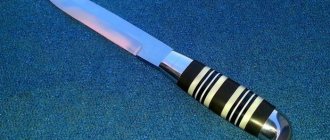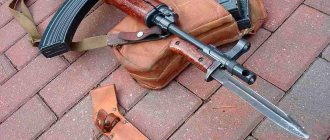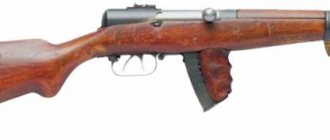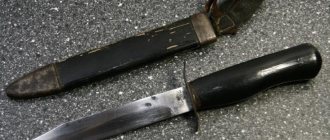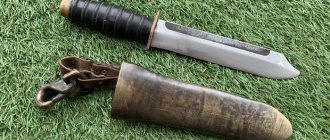Home | Links | Useful materials | Brands and modifications of the Nagan revolver
At the Tula Arms Plant (TOZ), branding was carried out as follows: on the left side of the revolver - production stamps (who produced it, when), and on the right side - test stamps (for strength, powder test "P" (on the barrel), after shooting on accuracy of fire "K" (on the frame under the drum), selection committee "double-headed eagle", "PM" in a circle or others (above the handle in the corner). Around the front sight - everything is the same - the TOZ sign and the marks of the technical process - the personal marks of the masters .
Soviet Nagans before 1931 for at least a year were almost an exact repetition of the tsarist ones. Apart from avoiding oak on the cheeks. But then the nature of the processing of the butt plate of the handle changed, the size of the fullers decreased, and so on. After 1931, the butt plate became more “sharp”.
Until the early 30s, you could come across a completely blue trigger, except for the pawl, screw and connecting rod spring, as well as the striker and its pin.
Modernization of the revolver began in 1929.
In order to save metal, they began to make a ramrod in two parts (the head was welded to the ramrod by electric welding) and made the front sight truncated.
Technological marks
"Hammer" . Russia - USSR, Tula, until 1929
State acceptance stamp.
On the parts of the revolver (drum, barrel, trigger parts, ramrod, ramrod tube, drum door, door spring) there are mainly quality control and acceptance marks. As an exception, the revolver number is marked on the end of the drum (as well as on the frame on the left side).
Until 1918, as a stamp of state acceptance, stamps in the form of a double-headed eagle with letters under it and in the form of a hammer enclosed in a circle were applied to parts of the revolver. Basically, this mark was placed on barrels (an option without a circle is also possible), triggers, triggers, breech blocks and sliders. Other parts of the revolver (frame, trigger guard, ramrod, ramrod tube, drum, drum door, drum axis, pawl, door spring) were applied with hammers without a wheel.
Since 1918, all parts of the revolver were branded with hammers without a circle, and since 1929, a star began to be used as the main mark of state acceptance.
However, by that time the warehouses had accumulated a fairly large number of revolver parts manufactured and adopted in Tsarist Russia and during the 1920s, and therefore parts “with hammers” may also be present on revolvers of the Soviet period of production, up to 1945 .
“Big Hammer” Russia-USSR, Tula, possibly before 1929.
State acceptance stamp (?)
The large hammer on the right side of the frame probably meant the same thing as the small one, but on a “general scale.” There are no exact data anywhere. One can only guess.
Since there are no repair marks on this example of the revolver, then, most likely, all the marks on it were originally of factory origin. The hammer (later star) mark on individual parts indicates that the part has been inspected by the technical control department. It is logical to assume that a large hammer is a test for compliance with the standard after assembling all components and the trigger as a whole, such as: trigger force, absence of jamming, etc. And the mark of the acceptance committee, again, it can be assumed, endorses the totality of the product passing all the tests required for it - powder test, accuracy test, trigger force and fitting of trigger parts, etc.
"Star" . USSR, Tula, since 1929
State acceptance stamp.
Since 1929, a star began to be used as the main stamp of state acceptance.
"Double-headed eagle" with letters on the right side of the frame. Russia, Tula, 1898-1917 (?)
State acceptance stamp.
In the period from 1898 to 1917, a revolver acceptance mark in the form of a double-headed eagle with letters below it was placed on the right side of the revolver frame. Letter marks could vary: PC, XX, IX. Perhaps it was used until 1918, when it was replaced by the “Forehead” stamp in a circle.
“ Forehead ” in a circle Stamp Quality Control Department, Laboratory (?), USSR, Tula (20s), possibly since 1918.
“ S ” in a rhombus Stamp Quality Control Department, USSR, Tula (year?)
Stands in the place where the mark of the admissions committee or receiver is usually placed
“ PI ” in a rhombus Stamp of Quality Control Department, USSR, Tula (year?)
“ ZB ” in a rhombus Stamp of Quality Control Department, USSR, Tula (year?)
“ ZR ” in a circle Stamp of Quality Control Department, USSR, Tula (year?)
“ PM ” in the oval Stamp of the Quality Control Department of the USSR, Tula (year?)
“ I ” in a diamond Stamp of the Quality Control Department of the USSR, Tula (year?)
" TK " united in a rhombus, oval or circle USSR, Tula, 1920-40.
Quality Control Sign. “TK” was placed in an oval until the mid-30s, then “TK” walked in a circle. “TK” in the oval is typical for the 20s. “TK” in a circle is for the 40s.
" U " in a circle, Tula (year?)
Placed on weapons that have passed the strength test.
" P " on the trunk, Tula (year?)
Powder test
" K " in a circle, Tula (year?)
Firing accuracy test mark
" R " in a circle on a ramrod tube, Belgium, 1896-98.
Powder test of the Nagant plant in Belgium, which was performed only at the L. Nagant plant in Belgium in 1896-1898. It is known that in 1898, by decision of the Armory Department of the GAU, spare parts for 20,000 revolvers were ordered in Belgium. 100 pcs of ramrod tubes were ordered. Release of Nagans in Belgium for Russia: 1895 - 1897 - 20,000; 1895 - 1899 - 180,000.
" UK " in a circle or truncated triangle
Trademark. Placed on weapons that have passed tests for strength, accuracy, accuracy
" H " in a circle or truncated triangle
Trademark. Installed on weapons that have passed the smoke or smokeless powder test
" C " in a circle, triangle
Inspector's marks
“ N ” in a circle, USSR, Izhevsk, 1940s.
A special mark on the weapons of Izhevsk, USSR, Izhevsk, 40s.
Stamp of Izhevsk Arsenal, after 1928
" P " squared
Test of acceptance by the state inspector of the quality of frame manufacturing
«P41«
Refurbished in 1941
" X " On the bracket. most likely a mark for intermediate acceptance of a part; on a 1931 revolver there is a letter “C” on the bracket in this place.
«1» in a triangle
Property mark of the GDR Army
Tula Cartridge Plant and its satellites
Tula Cartridge Plant, former factory of the heirs of V. S. Batashov. Founded -1919. Closed -1943.
These dry numbers tell, perhaps, about the most dramatic events. During this time, Trusts and associations of cartridge-tube and explosives production experienced the beginning, heyday and liquidation of NEP, industrialization and the beginning of the Great Patriotic War.
Years of work as part of various trusts were reflected in the name of the plant. And the marks that have survived to this day:
- N.K.T.P Tula Red Banner cartridge USSR. Military-Industrial Directorate under the Presidium of the Supreme Economic Council of the USSR (1926 - 1928).
Brand 1926-1928
- N.K.T.P Tula Red Banner cartridge USSR
Mark of the period 1928-1930
- T.P.Z. production Tul.cartridge plant
- Cartridge-tube trust (Pattrubtrest) of the Main Military-Industrial Directorate of the Supreme Economic Council of the USSR. 1926 – 1930.
- All-Union Association of Cartridge-Tube and Explosive Production (Patrubvzryv, Patrubvzryvobedinenie) of the Main Military Mobilization Directorate of the People's Commissariat of Heavy Industry of the USSR. 1930 – 1934 mobilization and planning management of the Supreme Economic Council of the USSR (1930 – 1932)
Mark of the period 1935-1943.
- All-Union cartridge case of the Main Military Mobilization Directorate of the People's Commissariat of Heavy Industry of the USSR (1932-1934)
- TPT tul.cartridge manager – 1935-1943.
- T.P.Z. production Tul.cartridge factory
Repair mark
A square divided in half.
1 description option. Near the wooden overlay there is a restoration mark - a rectangle divided in half. Such terminals had been installed for several years since 1928, while revolvers (triggers, springs, sights) worn out in the battles of the imperialist and civil wars were being repaired.
Option 2 description. Small repair marks - a rectangle divided in half (read “overhaul in 1932”, when they began to remake the sighting parts), which were placed since 1932 on revolvers produced earlier, i.e. The revolver with this mark was produced before 1932.
A diamond means a complete overhaul, which in turn means a complete or partial re-sorting of parts of the revolver. During the overhaul, they could change the drum and re-barrel, but this is less likely than simply replacing a worn-out trigger. The diamond sign is less common than a rectangle divided in half. Accordingly, it means a non-standard overhaul, or a special workshop. I think this sign indicates some kind of “fine” work on the revolver.
Features of revolver parts
General Features
Nagant revolver, produced by the Tula Arms Factory from 1895 to 1911
The front sight has a semicircular shape
On the right side of the frame there is a pin for fixing the door. The door, accordingly, has a slot
Revolver produced in 1912-1920
All design features are the same. They differ only in the brands.
Revolvers produced in 1921-1929.
In Soviet Russia, it was decided to produce only a self-cocking modification of the revolver, and the design of the Nagans of these years is of the same type as the previously produced officer models.
It should be noted that for some time revolvers with a rectangular front sight were produced, but almost immediately they returned to the semicircular one
Nagant revolver produced in 1930-1941
In the early 30s of the 20th century, the revolver underwent some modernization, which affected sighting devices:
- The sight slot became semicircular instead of triangular.
- They removed the pin under the door on the right side of the frame, and stopped making a slot on the door itself (although due to the huge backlog of doors with slots themselves, they continued to be installed)
- The corrugation on the revolver trigger has been changed (previously it was made in the form of a tooth on the upper, smooth part of the trigger, and now it is a rectangle)
- We changed the front sight, now it has become truncated.
Revolver produced in 1942-1945
Due to the evacuation of the plant to the Urals in 1941, production was curtailed.
At the same time, to reduce the cost of production, plastic handle cheeks began to be manufactured and installed instead of wooden ones.
Factories in Tula and Izhevsk officially produced revolvers until 1945 inclusive, although there is information that there are revolvers with marks of 1947 and even 1950. Most likely, these are assembled from the residual stock of parts.
In the 1960s, the revolver underwent another modernization, during which on almost all revolvers produced before 1930, the old semicircular front sight was replaced with a new truncated one, and the grip cheeks were also replaced from half-rotten wooden ones to plastic ones. All stored non-self-cocking revolvers produced before 1920 were converted into self-cocking ones.
Trigger guard
“Royal” trigger guards came with a number in the front part above the hammer. The serial number was placed on the bracket until 1914. There are no metal tides along the contour (the tide in the place of the lower eyelet of fastening the bracket to the frame axis (the transition at an angle from the 'straight' part to the 'eyelet' was until 1942. Then, during the Second World War, in order to speed up the technological process, the transition to the 'eyelet' was made smooth with fillet.
Drum
There is a mark on the front end of the drum. So, before 1938 this mark consisted of only four numbers, and after 1938 they began to add letters. (P, M...)
Drum door
After the modernization of 1930, doors, to simplify the technological process, began to be made without cutouts, respectively, for the purpose of unification (simplification of the technical process), the protrusion (stump) was no longer made on the frames, but on old samples released earlier, to simplify replacement in case of door wear, the ledge was removed. The door tooth serves to additionally secure the drum from turning in the opposite direction; with frequent use, it sometimes simply ground off, since when the drum is turned, it slides along it and falls into the groove when fixed. The lower tooth of the door also serves to fix the drum for unloading/loading the revolver when the door is open, and also wore out with frequent use.
Trigger
Until the end of the 20s, the corrugation on the trigger was in the form of a tooth (like on the Kremlin wall), and then they began to make it rectangular. I don’t know exactly when the corrugation was changed from a tooth to a rectangular one, probably before 1928.
Trunk
On the thickening in front of the ramrod tube “P” a powder test is carried out.
Front sight
The front sight is almost triangular in cross section (crest width 1.25mm), i.e. made before 1928 During the overhaul after 1928, it was sawn to the new adopted profile. Front sights manufactured after 1930 had a “Dynamo” shape adopted on May 7, 1930 by the NTK Commission of the Artillery Directorate with a truncated rear part with a cross section: trapezoid + rectangular comb 2 mm wide, and on all revolvers produced after the 30s the upper edge of the front sight was - flat.
In the future, it was allowed to have revolvers with two types of front sights.
The truncated front sight was finally approved in 1938. Later, the rear sight slot was changed to a semicircular one.
Until 1929, revolvers had a semicircular front sight. The rear sight slot was triangular.
Ramrod tube
The half-erased letter “R” is a powder test test at the Nagant plant in Belgium, which was installed only at the L. Nagant plant in Belgium in 1896-1898. It is known that in 1898, by decision of the Armory Department of the GAU, spare parts for 20,000 revolvers were ordered in Belgium.
Ramrod
At the end of the head there is a “circle with an inscribed triangle and an arrow inside” - the mark of the Izhevsk plant 1943-1945.
Second Tulpatronzavod and samovars. Know how
In 1919, it was decided to revive samovar production in the country. On January 1, 1919, the fate of large samovar factories was discussed. It was decided to nationalize the surviving factories of the heirs of V.S. Batashev, the Batashev brothers, the Shemarin brothers, and Teyle (formerly N.I. Batashev). It was decided to give the new plant, assembled from fragments of the old ones, a completely “original” name, which however completely repeated the old name - Tula Cartridge Plant. Why on earth did 4 factories, especially dedicated to samovars, unite under a meaningless name - the Tula Cartridge Plant? Perhaps, under this name, the history of enterprises is still silent about something.
There is a legend that the internal pipes for samovars (otherwise called “jugs”) are fully consistent with the caliber of military cartridges. Indeed, samovar jugs have two diameters - the pipe narrows towards the top and is very similar to a cartridge. Thanks to the narrowing, traction occurs. And the TPZ plant worked in peacetime, producing pipes for samovars, and during the war it made shells. A couple of employees of the TPZ enterprise once handed over samovars to us for repair and confirm this legend.
The same jug from the samovar
So, on January 11, 1919, the former samovar factories were transferred to the Tula Cartridge Plant, a state-owned enterprise created on the basis of the Batashev plant. By order of the state, this plant tried to produce samovars.
